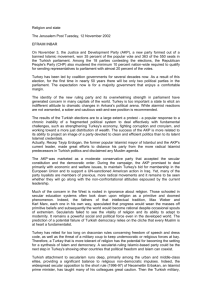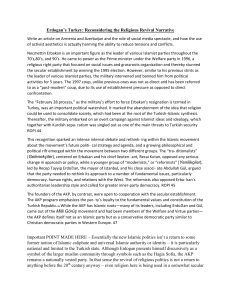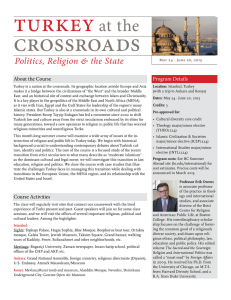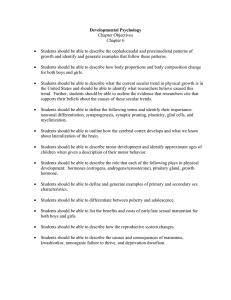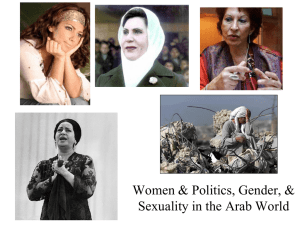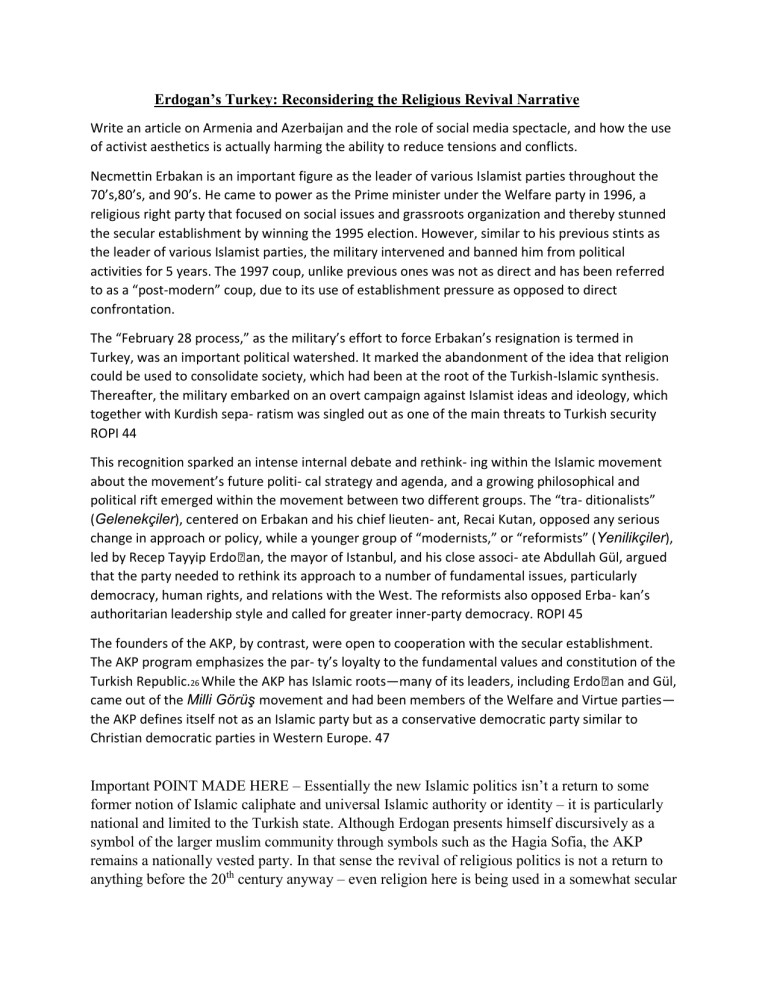
Erdogan’s Turkey: Reconsidering the Religious Revival Narrative Write an article on Armenia and Azerbaijan and the role of social media spectacle, and how the use of activist aesthetics is actually harming the ability to reduce tensions and conflicts. Necmettin Erbakan is an important figure as the leader of various Islamist parties throughout the 70’s,80’s, and 90’s. He came to power as the Prime minister under the Welfare party in 1996, a religious right party that focused on social issues and grassroots organization and thereby stunned the secular establishment by winning the 1995 election. However, similar to his previous stints as the leader of various Islamist parties, the military intervened and banned him from political activities for 5 years. The 1997 coup, unlike previous ones was not as direct and has been referred to as a “post-modern” coup, due to its use of establishment pressure as opposed to direct confrontation. The “February 28 process,” as the military’s effort to force Erbakan’s resignation is termed in Turkey, was an important political watershed. It marked the abandonment of the idea that religion could be used to consolidate society, which had been at the root of the Turkish-Islamic synthesis. Thereafter, the military embarked on an overt campaign against Islamist ideas and ideology, which together with Kurdish sepa- ratism was singled out as one of the main threats to Turkish security ROPI 44 This recognition sparked an intense internal debate and rethink- ing within the Islamic movement about the movement’s future politi- cal strategy and agenda, and a growing philosophical and political rift emerged within the movement between two different groups. The “tra- ditionalists” (Gelenekçiler), centered on Erbakan and his chief lieuten- ant, Recai Kutan, opposed any serious change in approach or policy, while a younger group of “modernists,” or “reformists” (Yenilikçiler), led by Recep Tayyip Erdo�an, the mayor of Istanbul, and his close associ- ate Abdullah Gül, argued that the party needed to rethink its approach to a number of fundamental issues, particularly democracy, human rights, and relations with the West. The reformists also opposed Erba- kan’s authoritarian leadership style and called for greater inner-party democracy. ROPI 45 The founders of the AKP, by contrast, were open to cooperation with the secular establishment. The AKP program emphasizes the par- ty’s loyalty to the fundamental values and constitution of the Turkish Republic.26 While the AKP has Islamic roots—many of its leaders, including Erdo�an and Gül, came out of the Milli Görüş movement and had been members of the Welfare and Virtue parties— the AKP defines itself not as an Islamic party but as a conservative democratic party similar to Christian democratic parties in Western Europe. 47 Important POINT MADE HERE – Essentially the new Islamic politics isn’t a return to some former notion of Islamic caliphate and universal Islamic authority or identity – it is particularly national and limited to the Turkish state. Although Erdogan presents himself discursively as a symbol of the larger muslim community through symbols such as the Hagia Sofia, the AKP remains a nationally vested party. In that sense the revival of religious politics is not a return to anything before the 20th century anyway – even religion here is being used in a somewhat secular sense – the strengthening of a national “Turkish” identity which itself was constructed in the 20th century Secular project. Necmettin Erbakan is an important figure as the leader of various Islamist parties throughout the 70’s,80’s, and 90’s. He came to power as the Prime minister under the Welfare party in 1996, a religious right party that focused on social issues and grassroots organization and thereby stunned the secular establishment by winning the 1995 election. However, similar to his previous stints as the leader of various Islamist parties, the military intervened and banned him from political activities for 5 years. The 1997 coup, unlike previous ones was not as direct and has been referred to as a “post-modern” coup, due to its use of establishment pressure as opposed to direct confrontation. The AKP does represent a revival of religious politics, but also a certain pragmatism whereby it isn’t afraid to stray from the conventional narratives which have dominated Turkey’s religious parties. It portrayed itself initially as neither anti-West, nor anti-European, and increasingly framed its discourse in “Western-friendly” terms such as human-rights, democracy, and liberalism. The AKP used a certain sense of cultural soft power to reflect religious authority, with Erdogan using symbolic religious posturing to flex his muscles in the Middle-East, while similarly attempting to integrate Turkey into a global economy and institutions such as the EU, which were previously seen as non-Islamic. Thus, the religious/secular divide itself is not as powerful in Turkey under the AKP, rather they use a pragmatic mix of religious and secular narratives to ensure their political survival. However, recent events have obviously complicated this narrative. After the failed 2015 coup, the ongoing journalists purges and incredulity towards Western responses has significantly soured EU-Turkey relations and bought Erdogan under increasing pressure domestically and abroad. This recent turn as well provides evidence that we shouldn’t view the AKP as a religious party necessarily. Most young-conservatives that have stopped supporting Erdogan are looking for a conservative alternative – not a religious one. The opposite of what we would expect, were Erdogan nothing more than a religious leader. The recent Gezi park protests further complicate the idea of a strict divide between religious and secular politics. Turkish citizens upset over the governments lack of free and open political expression, as well as interestingly, the transformation of public spaces into consumer resorts and shopping centers resonated throughout Turkish society. In particular, the Gezi protests amplified a strong social reaction against the government’s urban renewal policies. Erecting luxurious residences and skyscrapers all around the country, and replacing cities’ last remaining forest lands and squares with highways, shopping malls, grandiose mosques, hydroelectric and nuclear plants, and gigantic airports were identified by the protestors as the definite signs of the AKP’s authoritarian transformation of urban landscapes into profitable income resources. From the lens of the protestors, these ‘environmentally and culturally damaging’ urban renewal policies were a ‘new way of oppression’, threatening their lifestyles and subverting their feelings of belonging and attachment to their living spaces (Farro and Demirhisar 2014, 177). Just as Erdogan himself had initially been successful through a pragmatic approach whereby traditional Islamic symbolism was used in tandem with placating to the Anatolian bourgosie and a further neoliberal push in the Turkish economy, so too had the revolt against authoritarian practices equally become a hybrid mix between religious groups, secular groups, traditionalists and conservatives, and neoliberals and social reformers. Thereby, the future of Turkish politics, just as its past cannot be understood solely by the explanatory force of some supposed dichotomy between religious and secular politics; instead the operationalization of these narratives by both the state and the citizenry will have to be examined going forward. CITATION BLOCKS After Atatürk’s death in 1938, the authoritarian tendencies of the regime intensified. Atatürk’s successor, İsmet İnönü, sought to build the regime’s legitimacy on a strict interpretation of Kemalism. One- party rule served as a means to carry out a radical transformation of Turkish society. The majority of the population remained outside of politics and wedded to traditional habits and lifestyles over which Islam continued to exert an important influence. In a sense, what has occurred over the past several decades is an attempt by this marginalized periphery to find its political voice and representation. Political Islam has increasingly provided that voice. Over time, the political goals and ideology of the Islamic movement have evolved, and it has jettisoned or moderated many key tenets of its initial political agenda, particularly its hostility to Westernization, in an effort to attract broader political support. ROPI 35 Ironically, the military contributed to the strengthening of politi- cal Islam in Turkey. An upsurge of left-wing and right-wing violence that brought Turkey to the brink of civil war in the 1970s eventually prompted the military to intervene in 1980 to restore order.11 In an effort to combat communism and leftist ideologies, the military attempted to strengthen the role of Islam. Under the military’s tute- lage, religious education was made a compulsory subject in all schools. Quranic classes were opened, and state-controlled moral and religious education was promoted ROPI 37 In effect, the military sought to institute a process of state- controlled “Islamization from above.” By fusing Islamic symbols with nationalism, the military hoped to create a more homogeneous and less political Islamic community and to insulate the population from the influence of left-wing ideologies ROPI 37 The rise of political Islam in Turkey has its roots in the reforms under- taken in the late Ottoman period and in the nature of the political transformation undertaken after the founding of the Turkish Republic by Mustafa Kemal Atatürk in 1923.2 Atatürk’s attempt to transform Turkey into a modern, Western, secular state essentially represented a “revolution from above.” It was a state-instituted, top-down enterprise in social engineering carried out by a small militarybureaucratic elite that imposed its secularist vision on a reluctant traditional society. In carrying out this transformation, the elite made little effort to co-opt or cajole the population or the opposition. As Do�u Ergil noted, “Neither the secularization nor the Turkification of the nation was negotiated with the people in a serious way.”3 Instead the elite simply tried to use the “strong state” to overwhelm and intimidate any opposition.4 ROPI 33 However, most of these reforms were limited to the urban centers; the countryside remained largely untouched. Until the 1950s, the bulk of the Turkish population remained isolated and traditional, while the urban centers were modern and secular. In effect, two Turkeys coex- isted in uneasy harmony: an urban, modern, secular “center” and a rural, traditional, religious “periphery,”5 ROPI 33 The architects of this ideological program hoped to create a new form of depoliticized TurkishIslamic culture that would reunify soci- ety and provide the basis for a unified, strong, and stable state. The syn- thesis, however, sent an ambiguous message. On one hand, under the 1982 constitution, Turkey was defined as a secular state. On the other hand, the role of religion was strengthened in schools and education as a means of reinforcing Turkish nationalism, which tended to weaken the emphasis on secularism. At the same time, it provided opportuni- ties for the Islamists to expand and reinforce their own message. ROPI 38 These economic and social changes contributed to an upsurge in the political strength of Islamic political groups in the 1970s and 1980s. Its first independent political expression was the establishment of the National Order Party (MNP) in January 1970. The MNP was the first of several Islamic parties led by Necmettin Erbakan. It advocated a new economic and social order based on “national” (read Islamic) principles. However, the MNP’s existence was short-lived. The party was shut down after a military intervention in 1971 on the grounds that it was against the secular nature of the state. The founders of the MNP and its successors came out of the National View (Milli Görüş) movement,17 whose leaders sought a return to traditional values and institutions. They regarded the Kemalist attempt to replace the Islamic-Ottoman state and culture with a West- ern model as a historic mistake and the source of all the ills in Turkish society. Their goal was to build a “national (Islamic) order” and put an end to the process of Westernization.18 They saw Turkey’s identity and future closely linked with the Muslim world, rather than with the West. ROPI 40 Important POINT MADE HERE – Essentially the new Islamic politics isn’t a return to some former notion of Islamic caliphate and universal Islamic authority or identity – it is particularly national and limited to the Turkish state. Although Erdogan presents himself discursively as a symbol of the larger muslim community through symbols such as the Hagia Sofia, the AKP remains a nationally vested party. In that sense the revival of religious politics is not a return to anything before the 20th century anyway – even religion here is being used in a somewhat secular sense – the strengthening of a national “Turkish” identity which itself was constructed in the 20th century Secular project. Necmettin Erbakan is an important figure as the leader of various Islamist parties throughout the 70’s,80’s, and 90’s. He came to power as the Prime minister under the Welfare party in 1996, a religious right party that focused on social issues and grassroots organization and thereby stunned the secular establishment by winning the 1995 election. However, similar to his previous stints as the leader of various Islamist parties, the military intervened and banned him from political activities for 5 years. The 1997 coup, unlike previous ones was not as direct and has been referred to as a “post-modern” coup, due to its use of establishment pressure as opposed to direct confrontation. The “February 28 process,” as the military’s effort to force Erbakan’s resignation is termed in Turkey, was an important political watershed. It marked the abandonment of the idea that religion could be used to consolidate society, which had been at the root of the Turkish-Islamic synthesis. Thereafter, the military embarked on an overt campaign against Islamist ideas and ideology, which together with Kurdish sepa- ratism was singled out as one of the main threats to Turkish security ROPI 44 This recognition sparked an intense internal debate and rethink- ing within the Islamic movement about the movement’s future politi- cal strategy and agenda, and a growing philosophical and political rift emerged within the movement between two different groups. The “tra- ditionalists” (Gelenekçiler), centered on Erbakan and his chief lieuten- ant, Recai Kutan, opposed any serious change in approach or policy, while a younger group of “modernists,” or “reformists” (Yenilikçiler), led by Recep Tayyip Erdo�an, the mayor of Istanbul, and his close associ- ate Abdullah Gül, argued that the party needed to rethink its approach to a number of fundamental issues, particularly democracy, human rights, and relations with the West. The reformists also opposed Erba- kan’s authoritarian leadership style and called for greater inner-party democracy. ROPI 45 The founders of the AKP, by contrast, were open to cooperation with the secular establishment. The AKP program emphasizes the par- ty’s loyalty to the fundamental values and constitution of the Turkish Republic.26 While the AKP has Islamic roots—many of its leaders, including Erdo�an and Gül, came out of the Milli Görüş movement and had been members of the Welfare and Virtue parties— the AKP defines itself not as an Islamic party but as a conservative democratic party similar to Christian democratic parties in Western Europe. 47 Whereas it received 34 percent of the vote in the November 2002 election, it obtained 46.6 percent of the vote in the July 22, 2007, election—an increase of more than 12 percent. Moreover, the AKP increased its electoral support in all seven regions of the country. The most important increases occurred in the predominantly Kurdish areas of southeastern Anatolia. The AKP also increased its support in the five largest cities in Turkey. In Istanbul, it received almost as many votes as all its opponents combined. This suggests that the AKP is gradually extending its hold from the periphery toward the city centers. The par- ty’s main support, however, comes from the poorer and lessdeveloped parts of the cities (the varo�). 49 While the 2007 election showed clear cleavages between the center and the periphery, with the CHP doing best in the wealthier parts of the larger cities, it also showed, as Tanju Tosun has pointed out, that the AKP represents a catch-all party and should not be regarded as a religious party.29 Indeed, the support it received from different social groups gives the AKP the attributes of a centerright party. 50 The AKP does represent a revival of religious politics, but also a certain pragmatism whereby it isn’t afraid to stray from the conventional narratives which have dominated Turkey’s religious parties. It portrayed itself initially as neither anti-West, nor anti-European, and increasingly framed its discourse in “Western-friendly” terms such as human-rights, democracy, and liberalism. The AKP used a certain sense of cultural soft power to reflect religious authority, with Erdogan using symbolic religious posturing to flex his muscles in the Middle-East, while similarly attempting to integrate Turkey into a global economy and institutions such as the EU, which were previously seen as non-Islamic. Thus, the religious/secular divide itself is not as powerful in Turkey under the AKP, rather they use a pragmatic mix of religious and secular narratives to ensure their political survival. However, recent events have obviously complicated this narrative. After the failed 2015 coup, the ongoing journalists purges and incredulity towards Western responses has significantly soured EUTurkey relations and bought Erdogan under increasing pressure domestically and abroad. This recent turn as well provides evidence that we shouldn’t view the AKP as a religious party necessarily. Most young-conservatives that have stopped supporting Erdogan are looking for a conservative alternative – not a religious one. The opposite of what we would expect, were Erdogan nothing more than a religious leader. The recent Gezi park protests further complicate the idea of a strict divide between religious and secular politics. Turkish citizens upset over the governments lack of free and open political expression, as well as interestingly, the transformation of public spaces into consumer resorts and shopping centers resonated throughout Turkish society. In particular, the Gezi protests amplified a strong social reaction against the government’s urban renewal policies. Erecting luxurious residences and skyscrapers all around the country, and replacing cities’ last remaining forest lands and squares with highways, shopping malls, grandiose mosques, hydroelectric and nuclear plants, and gigantic airports were identified by the protestors as the definite signs of the AKP’s authoritarian transformation of urban landscapes into profitable income resources. From the lens of the protestors, these ‘environmentally and culturally damaging’ urban renewal policies were a ‘new way of oppression’, threatening their lifestyles and subverting their feelings of belonging and attachment to their living spaces (Farro and Demirhisar 2014, 177). The Anti-Capitalist Muslims’ invitation of secular communities to such an Islamic-oriented political event, as well as the remarkable interest shown by secular communities towards this ‘Islamic political’ form of protest, raised important questions regarding the potentiality of the Gezi protests to defy the long-standing boundary between secular and Islamic communities – a boundary that has regenerated the ‘secular/Islamic divide’ as a hegemonic rule in characterising Turkish politics for more than three decades (Damar 2012, 2014). Just as Erdogan himself had initially been successful through a pragmatic approach whereby traditional Islamic symbolism was used in tandem with placating to the Anatolian bourgosie and a further neoliberal push in the Turkish economy, so too had the revolt against authoritarian practices equally become a hybrid mix between religious groups, secular groups, traditionalists and conservatives, and neoliberals and social reformers. Thereby, the future of Turkish politics, just as its past cannot be understood solely by the explanatory force of some supposed dichotomy between religious and secular politics; instead the operationalization of these narratives by both the state and the citizenry will have to be examined going forward. In the words of Mustafa Kemal Atatürk, it aimed to “liberate the religion of Islam, within which we have been living peacefully and happily with devotion, from the customary ways in which it has become a means of politics [vasıta-i siyaset] (Bravo, applause).”6 (secularism in France and Turkey 201) After the coup d’état in 1980, the Kemalist military constitutionalized compulsory Sunni religion courses in the public school curriculum and redefined the constitutional role of statesalaried imams as serving national solidarity. The portion of the literature that takes Kemalist laicism as anticlerical qualifies this moment either as a mere contradiction or as some kind of necessity emerging from the different nature of Islam for reaching laicism in a Muslim society. However, the constituent assembly debates in the making of the military constitution of 1982 show that the military’s institutional preferences came from an explicit interest in mobilizing religion (as the cement of society) against leftist movements and had nothing to do with the “threat of Islam.” (secularism in france and turkey 200) In a speech he gave in January 1923, Mustafa Kemal stated that “our religion is the most reasonable and most natural religion, and it is precisely for this reason that it has been the last religion. In order for a religion to be natural, it should conform to reason, technology, science, and logic. Our religion is totally compatible with these.”11 (secularism in france and turkey, 203) there is danger in it of the use of religion for political ends. Now that the state has rid itself entirely of religious control, it should, in turn, leave Islam alone.… Adivar, in Yale Law Review, 206 SFT Twenty-nine İmam Hatip four-year secondary schools (schools for the education of Muslim clerics) were established in 1924 in place of the medreses in order to bring up imams and preachers loyal to the Republic.26 The number of İmam Hatip schools declined steadily from 1924 until 1930 because of a lack of students, and in the 1929–30 academic year they were all closed. The Faculty of Theology at Istanbul University was closed in 1933, after a report by a European scholar documented the small number of registered students. 209 SFT Sinan Tekelioğlu That means, we have given the administration of their pious foundations to them and placed the “Directorate of Religious Affairs” at the head of the religious community belonging to the religion of Islam.… But we have left its hands tied.… Whereas christian and jewish Turkish religious communities have established schools for themselves, have trained priests, rabbis, and grave diggers. But the Turks who constitute 8/10 of this country … do not even have someone to bury their dead. 220 SFT
